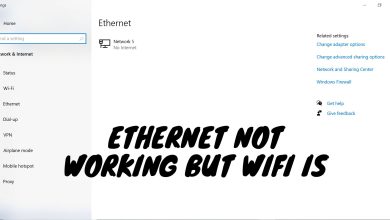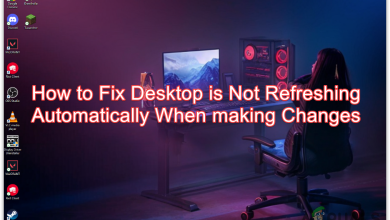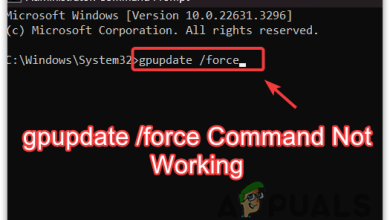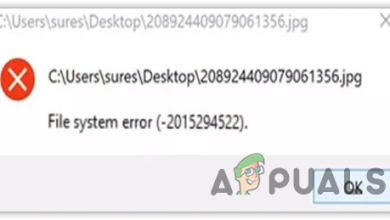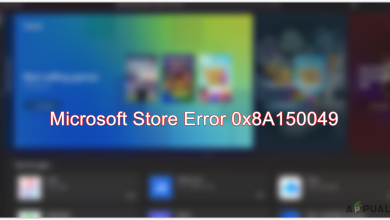Fix: ‘Unreal Engine is exiting due to D3D device being lost’
Users experience the error message ‘Unreal Engine is exiting due to D3D device being lost’ when Unreal is unable to connect with the D3D device on your computer. This error is very common and can also occur for users who have no apparent issues on their computers.

According to Unreal Engine developers, this issue usually occurs when the computer’s graphics or hardware components are not being properly synchronized with Unreal Engine which in turn causes it not to work properly with D3D device. In this article, we will go through all the solutions as to why this issue occurs and also, what are the workarounds to solve it.
What causes the Error ‘Unreal Engine is exiting due to D3D device being lost’?
After receiving numerous reports from users about the issue, we decided to investigate the problem. After combining these reports, we duplicated the situations in our workstations and worked out the causes. The reasons as to why you might experience this error message are but not limited to:
- Outdated Unreal Engine: The most probable cause is where the Unreal Engine is not updated to the latest build and is not able to communicate with other system components which might be updated recently. It can also be the other way around.
- Antivirus software: There are numerous antivirus software out there which tend to block the Unreal Engine, hence marking a false positive. This is very common and can be solved by either creating a whitelist or disabling it.
- Outdated Device Drivers: Another probable cause as to why this issue occurs is that your device drivers are either corrupt or outdated. In both cases, reinstalling or updating the drivers work.
- Incomplete Steam Files: Steam often works with Unreal Engine. If its game/installation files are corrupt or incomplete, you will experience the error message under discussion.
- NVIDIA GeForce Settings: These modules are also known to conflict with the game. Disabling the module or disabling specific settings usually solves the problem.
- Overclocking: Overclocking might give your PC the push it needs but is known to cause issues or conflicts with heavy resource-consuming applications. Disabling Overclocking might do the trick for you.
- Default Graphics card: The default graphics card usually disables itself when a dedicated one with more power is running. However, in several cases, it might be active alongside the dedicated graphics card and cause conflicts which will further cause issues.
Before you start with the solutions, make sure that you are logged in as an administrator. Furthermore, you should have an active and open internet connection.
Solution 1: Updating Unreal Engine, Windows, and Steam
Usually, if either of the components mentioned is outdated, they have issues communicating with each other. With poor communication, the game cannot run properly. This is a very common recurring issue and users often overlook this.
The method to update the Unreal engine is a bit lengthy but Windows and Steam update in a jiffy. Make sure that you are logged in as an administrator and follow the steps in the exact order. We will start by updating the Unreal Engine.
- Open the Launcher and navigate to the Library
- Once in Library, at the top, you would be able to see the Engine version. If there is an update available, you will see a plus icon right next to it.
- Click on the Add versions and when you click it, a prompt will be given to install the new engine. Download the engine version accordingly and click on Update.

Updating Unreal Engine
Now that Unreal Engine is updated, we will proceed by updating Windows.
- Press Windows + S, type “update” in the dialogue box, and open the Update result when returned.
- Now, click on the button of Check for updates. Now, Windows will automatically start checking the online servers if there is any update available to be installed.

Updating Windows
Be patient and let the process complete. After the process is completed, if prompted, restart your computer. After restarting, follow the steps below to update Steam.
- Launch the Steam client and make sure that you have an active internet connection.
- The client, after checking the online servers will automatically start downloading the latest update. After the update is downloaded, restart the computer again.
After all the modules have been updated, try running Unreal Engine and see if the error still persists. If it does, follow the steps below.
Solution 2: Disabling NVIDIA Game Booster (or other functions)
Another thing to try before we move on is making sure that no ‘enhancement’ features are active in NVIDIA’s GeForce Experience. Even though these functions might alter the settings and provide you with additional performance, they are known to cause several issues.

These ‘enhancement’ functions are mostly features like Game Booster, Battery Optimizer, etc. Open the GeForce Experience (or relevant application) and make sure these are completely disabled. You can also temporarily disable the GeForce Experience altogether and see if this works. Once you are absolutely sure that the issue isn’t because of these features, you can move on with other solutions.
Solution 3: Changing the Preference for Dedicated Graphics
Usually, people who use Unreal Engine and play its games are known to have their own dedicated graphics installed on their computer. Dedicated graphics are usually added later on on-top of the in-build graphics module by Intel (known as Intel HD or Intel UHD).
However, the being of two graphics modules in a single computer induces several issues which is of no surprise. In this solution, we will navigate to the control panel of NVIDIA and then after selecting Unreal Engine, make sure it is customized to run on NVIDIA graphics drivers only.
- Right-click anywhere on your Desktop and select NVIDIA control panel.
- Once the control panel is opened up, click on Manage 3D Settings. Now click on Program settings.
- Now, you will see a drop-down containing the list of all programs. Add Unreal Engine and select NVIDIA (Dedicated graphics) from the second drop-down.
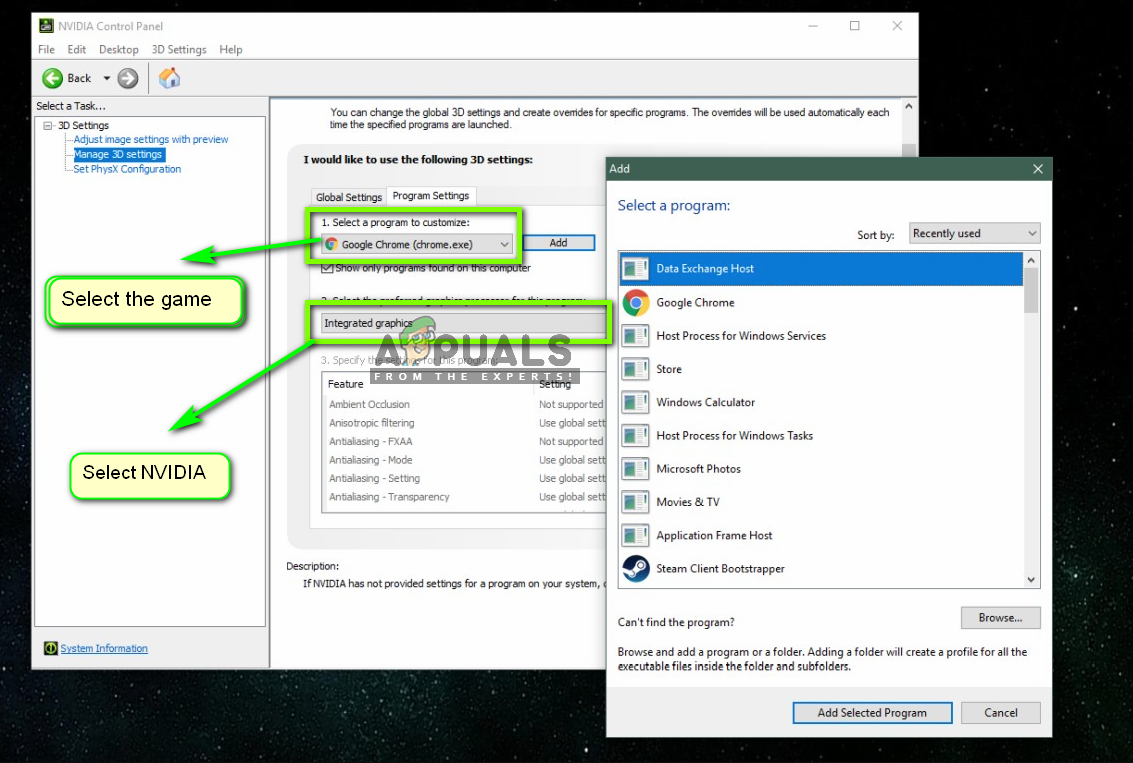
Changing preference of Graphics Card - Save changes and exit. Restart your computer and try launching the module/game and see if this solves the issue.
Solution 4: Disabling on-board Graphics
Another thing to try is completely disabling the onboard graphics on your computer. This might help if only changing the preference of the graphics isn’t enough to make the problem go away. Do note that this will not affect your computer’s performance or functionality; only now, your dedicated graphics will be doing the entire weight lifting while the in-built ones will stay inactive. Make sure that you are logged in as an administrator before proceeding.
- Press Windows + R, type “devmgmt.msc” in the dialogue box, and press Enter.
- Once in the device manager, navigate to Display adapters and select the on-board
- Now, right-click on it and select Disable.
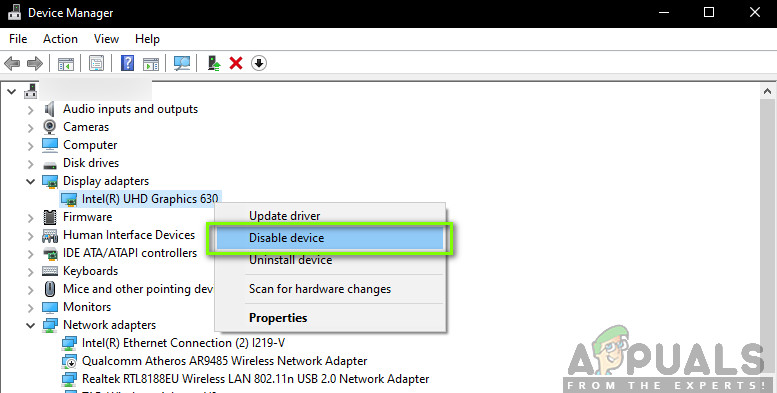
Disabling on-board Graphics
For a short moment, your screen will probably go blank but will come back up. Here, the computer is shifting completely to your dedicated graphics. Save changes and exit. Now try launching Unreal Engine and see if the issue persists.
Solution 5: Disabling Antivirus/Firewall Software
Antivirus software keeps you safe by analyzing all the system files in your computer and also checking all the running processes which seem to take up resources. However, there are numerous instances where it marks a ‘verified’ process as malware; hence called a false positive. This situation happens with a lot of different games and is known to either disable the game from running altogether or not granting it enough permissions to access the said resources. The same is the case with Antivirus software and Unreal Engine.
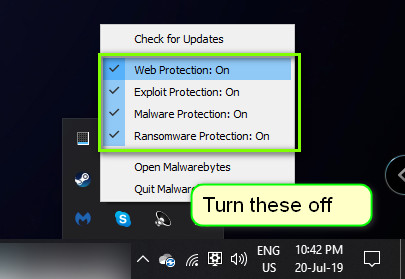
Hence you should try disabling your Antivirus software. You can check out our article on How to turn your Antivirus off. After disabling your Antivirus, restart your computer and try streaming again. If disabling the Antivirus doesn’t work, you can try uninstalling it and see if it does the trick for you. Some noticeable Antivirus software that was causing issues was Avast and AVG. Nonetheless, you should try disabling whichever Antivirus you have and see if this does the trick.
Solution 6: Disabling Overclocking and SLI Technology
Overclocking means making the processor perform short-lived burst computations to give your PC a push in its processing power. When it does this, the temperature of the processor rises and when it has risen to the limit, it reverts back to normal processing. During this time, the processor cools off and hence gets ready to perform another burst when it is cool enough.

Despite the advanced features and usefulness of overclocking, we received several reports from users where they reported that disabling overclocking for both the CPU and graphics card fixed the issue. It seems that the Unreal Engine is not optimized to run in an accelerated overclocked environment.
Furthermore, on top of disabling overclocking for graphics/CPU, we also received reports that disabling SLI also did the trick for numerous users. SLI is a brand name managed by NVIDIA whose primary purpose is to link two graphics cards together so their power can be combined. Like the case of normal overclocking, Unreal Engine also has trouble when SLI is active. Hence you should try disabling it from your computer and see if this does the trick.
Solution 7: Updating Graphics Drivers
Graphics drivers are the main modules that enable the communication between your Graphics hardware and the operating system (applications or games etc.). If the graphics drivers themselves are not working properly, you will experience issues with almost all graphics demanding applications like Unreal Engine. In this solution, we will uninstall your existing graphics drivers and install newer ones later on.
- Download and install DDU (Display driver uninstaller) from its official website.
- After installing Display Driver Uninstaller (DDU), launch your computer in safe mode. You can check our article on how to boot your computer into safe mode.
- After launching the DDU, select the first option “Clean and restart”. This will uninstall the current drivers completely from your computer.
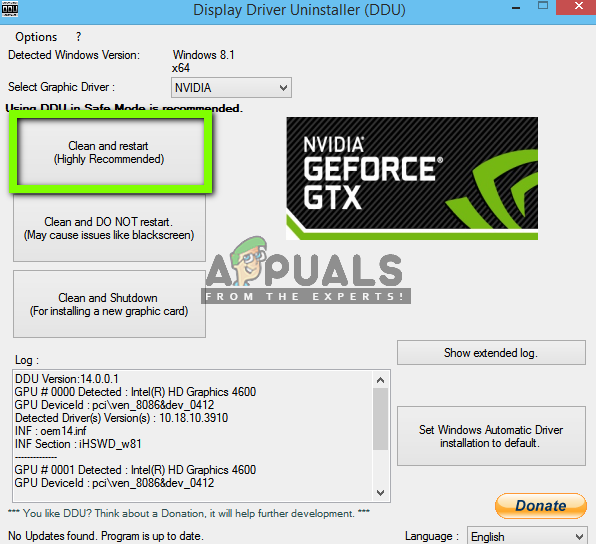
Cleaning Drivers - Now after the uninstallation, boot your computer normally without safe mode. Press Windows + R, type “devmgmt.msc” in the dialogue box and press Enter. Right-click on any empty space and select “Search for hardware changes”. The default drivers will be installed. Try launching the Display Capture and check if this solves the problem.
Note: You might have to perform solution 1 again after this step. - In the majority of the cases, the default drivers will not work for you so you can either install the latest drivers through Windows update or navigate to your manufacturer’s website and download the latest ones.
- After you have installed the drivers, restart your computer and check if the problem is solved.
Solution 8: Disable Full-screen mode
You can try to disable the Fullscreen mode in the game that you are trying to play because this has reportedly fixed the issue for some users. Being in Windowed mode is known to fix this issue for some Unreal Engine Games.
Solution 9: Reinstalling DirectX and changing FreeSync Settings
If none of the above methods work, we can try reinstalling DirectX completely and change the FreeSync settings. This is a fairly straightforward method but you have to reinstall DirectX manually after downloading it from the website.
- Reinstall DirectX on your computer and then restart it before proceeding ahead.
- Now, if you have a FreeSync monitor, navigate to GSync settings through the GeForce Experience application.
- Once you locate your FreeSync monitor settings, Enable for Full-Screen option. Check the box for Enable settings for selected Display as well.
- Restart your computer completely after making changes and see if this solves the problem.
You can also test the same procedure for ‘Windowed mode’.
